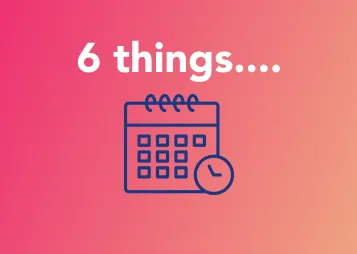We asked Jiminny’s own Head of RevOps, Dan, to explain how to tackle your first 30 days in this invaluable business function.
First up - congratulations on your new role in Revenue Operations (RevOps)!
Whatever company you’re starting at, you’re in for an exciting journey and the first 30 days are crucial for establishing a strong foundation. You’re setting the stage for your success in optimizing and aligning your company's revenue-generating functions.
Here are my six things to do in your first 30 days to make that happen.
#1 Get to grips with the current data
Data is the lifeblood of RevOps, and understanding your company's existing data is the first step to streamline and improve revenue operations.
Begin with a comprehensive data audit. Identify where your company's data lives, what tools and systems are used, and who manages and utilizes it. Check that data is organized and accessible.
Make sure you understand the data in the GTM software. This includes custom fields, any bespoke reporting and the underlying calculations behind it. Time periods are often specific to each business and even things like ARR can be calculated differently in different businesses so go granular here.
Once you’ve done this, here are a few areas to dig deeper into:
Data quality: Consider the quality and hygiene of the data. Are there duplicates, inaccuracies or inconsistencies?
Data sources: Identify all the sources of data—CRM, marketing automation, sales tools, finance systems, etc. Understanding where data is generated and how it flows will be essential to implementing changes successfully in the future.
Data governance: Examine data governance policies and practices in place. Find and check any guidelines for data management, including ownership, security, and compliance.
Key metrics: Familiarize yourself with the KPIs and metrics that drive revenue. Understand how they are measured and what they mean for the business and departments within it.
Reporting tools: Get acquainted with the tech stack, reporting tools and dashboards currently in use. Ask yourself - do they provide actionable insights for decision-making?
By getting under the surface of your current data landscape, you'll have a clear understanding of the data-related challenges and opportunities that lie ahead.
#2 Learn how to replicate current data and reports
To be effective in your RevOps role, you need to know how and why things are done the way they are in your company - even if they have suggested to you they want this to change.
This exercise serves several purposes:
- Validates your understanding of how their data flows work
- Identifies any complex manual processes or tribal knowledge required for reports
- Positions you to improve or rebuild reports later on
- Allows you to produce reports yourself if needed while you're getting up to speed
Consider:
Data architecture: Study the formation of your company's data. How is it structured, and what are the relationships between different datasets? Familiarize yourself with data models and schemas.
Report generation: Learn how reports are generated. Is there a standard process or system in place? Understand the tools and technologies used for report creation.
Report purpose: Ask why specific reports are created and how they serve the business. This will help you appreciate the historical context and the decision-making process.
User feedback: Gather feedback from the end-users of reports and dashboards. What information do they find valuable, and what do they think could be improved?
#3 Get the low-down on processes and pain points
Your first 30 days are all about immersing yourself in the inner workings of the business. Building on your knowledge of the data, understanding the business’ processes and pain points will give you insights into how you can drive impactful and meaningful change:
Process mapping: Create process maps to visualize how different departments and teams interact in the customer journey. Identify bottlenecks and inefficiencies.
Stakeholder interviews: Conduct interviews with key stakeholders in sales, marketing, and finance. Ask about their challenges and frustrations related to revenue operations. Pay special attention to identifying their biggest pain points and roadblocks.
A few key questions to ask could be:
- Where do opportunities frequently fall through the cracks?
- Where do bottlenecks occur?
- What causes the most frustration or friction?
- What are the most tedious and manual processes?
Shadowing: Spend time shadowing sales reps, marketing teams and finance professionals. Gain firsthand experience and empathy for their day-to-day activities. Then listen back to sales call recordings along the process and listen to customer QBR calls to better understand the customer problems your business solves.
Customer journey: Trace the customer journey from awareness to conversion and beyond. Identify touchpoints and areas where alignment can be improved.
Data flow analysis: Analyze how data flows through the organization. Identify any data handoffs and areas where data silos exist.
By understanding the existing processes and pain points, you'll be better equipped to propose solutions and optimizations that will enhance the overall revenue operation. Without this knowledge, changes you implement in the future might have unintended consequences thanks to ripple effects in interconnected processes.
#4 Prepare your vision
After gathering insights into your company's data, reports, processes, and pain points, it's time to prepare your vision for the RevOps function.
Alignment strategy: Develop a strategy to ensure that sales, marketing, and finance are aligned in their objectives, processes, and metrics. How can you create a unified approach?
Tech stack: Assess the existing technology stack and propose improvements. Consider whether new tools or integrations are needed to enhance efficiency.
Data governance plan: Create a data governance plan that outlines data ownership, security, and compliance measures. Define roles and responsibilities in data management.
KPIs and metrics: Refine the KPIs and metrics that matter most to your company's revenue operations. Establish a performance dashboard that provides real-time insights.
Change management: Develop a change management plan to ensure that your vision is effectively communicated and embraced across the organization. If this isn’t your first RevOps role, bring in ideas from past experience. Thoughts and experience from other industries could be the fresh perspective this RevOps function needed.
Big picture, your vision for RevOps should aim to streamline operations, drive revenue growth, and enhance cross-functional collaboration. Sketch out a high-level roadmap and milestones for the first 6-12 months. Focus on the outcomes rather than specific tactical steps for now as these can be built out in the weeks to come.
#5 Sync into the operating rhythm
Like joining any new company, syncing up with their operating and meeting rhythm can feel like you’re living in a whole new world. So even if it feels uncomfortable or you think you have a better way of doing things, sync up with your new colleagues to begin with.
Meeting cadence: Understand the meeting schedule and cadence within your organization. When and how do sales, marketing, and finance teams meet to discuss performance and strategy? Observe how teams interact, where there's friction, and how decisions get made.
Attend meetings: Be present, even if it's in an observer capacity initially. This will help you understand the dynamics, key topics, and pain points discussed. Also pay close attention to the cadence of how results get reviewed. Figure out when critical reports need to be produced and when/how feedback is given. You'll want to align the operations and reporting you own to their cycles.
Contribute meaningfully: As you gain a deeper understanding of the meetings and their purpose, begin contributing incrementally. Share insights and suggestions that align with your vision for RevOps.
Cross-functional collaboration: Encourage cross-functional collaboration in and out of meetings. Promote discussions and initiatives that foster alignment and teamwork.
Synchronizing with your company's operating rhythm will enable you to have a more immediate impact when you do start to implement changes and will help you be seen as a valuable contributor to the team.
#6 Remember: don’t try to flip things upside down on Day 1
It's essential to remind yourself that the first 30 days in your RevOps role are primarily about learning and thinking, not implementing sweeping changes. While you may be eager to make a difference, rushing into changes without a thorough understanding of the current state can lead to unintended consequences.
During this time, focus on building relationships, understanding the nuances of your organization, and gaining the insights needed to formulate a well-informed plan. Here are some tips to keep in mind:
- Listen actively: Be an active listener during your conversations and meetings. Pay attention to what others are saying and the underlying challenges they face.
- Ask questions: Don't hesitate to ask questions. Seek clarity on processes, data, and reports to fill gaps in your understanding.
- Build relationships: Establish relationships with everyone you intend to be working with from CEO/CRO to the sales support apprentice. Effective collaboration requires trust and rapport on numerous levels.
- Document your findings: Keep notes on EVERYTHING - your discoveries, pain points and potential solutions. This will serve as a valuable resource as you move forward.
Your first 30 days in a RevOps role are a critical period for learning, understanding, and strategizing. Your impact and improvements will play out in the long game so be patient during these first few weeks and know that your best is yet to come.
Dan Wilson is the Head of Revenue Operations at Jiminny, implementing new strategies and procedures to improve efficiency, performance, and customer satisfaction across the sales cycle and beyond. With over eight years in operations and five years with revenue teams, Daniel has managed and coached teams through numerous challenging situations. He is endlessly passionate about using data, insights and human interactions to drive business decisions and optimize business processes.





.webp)






